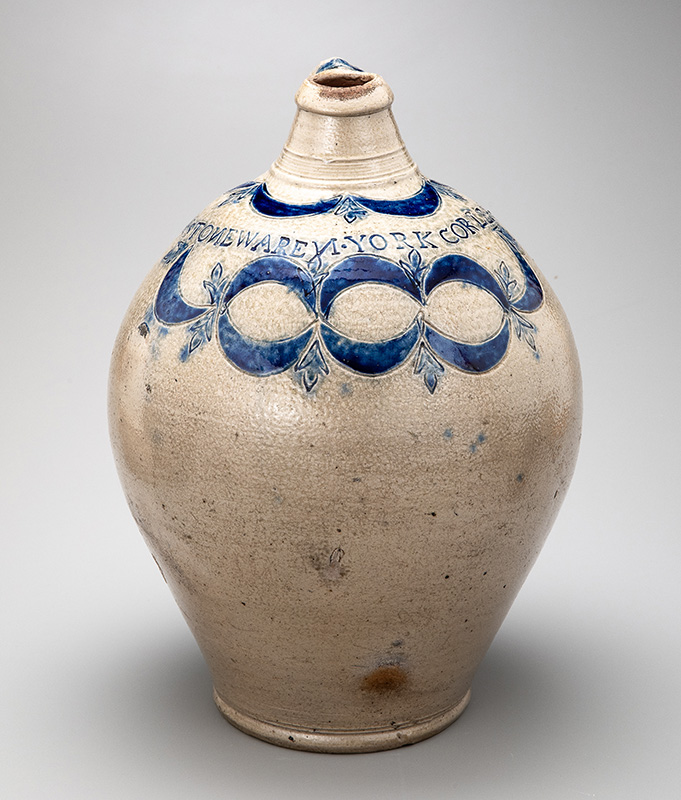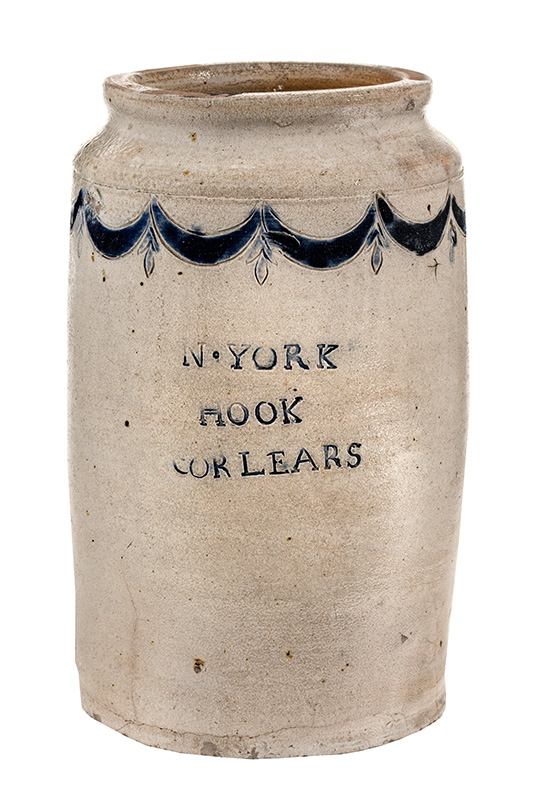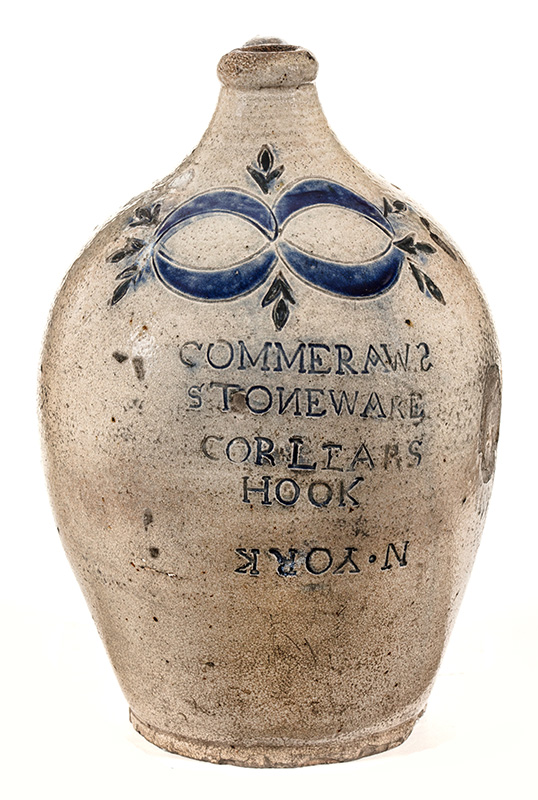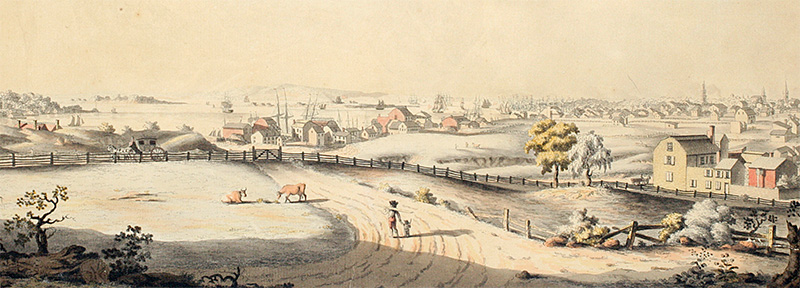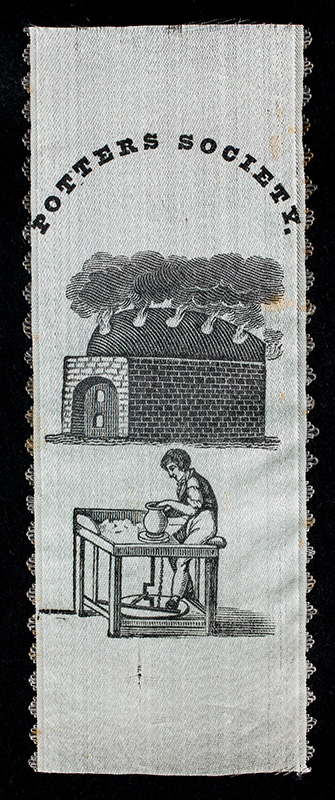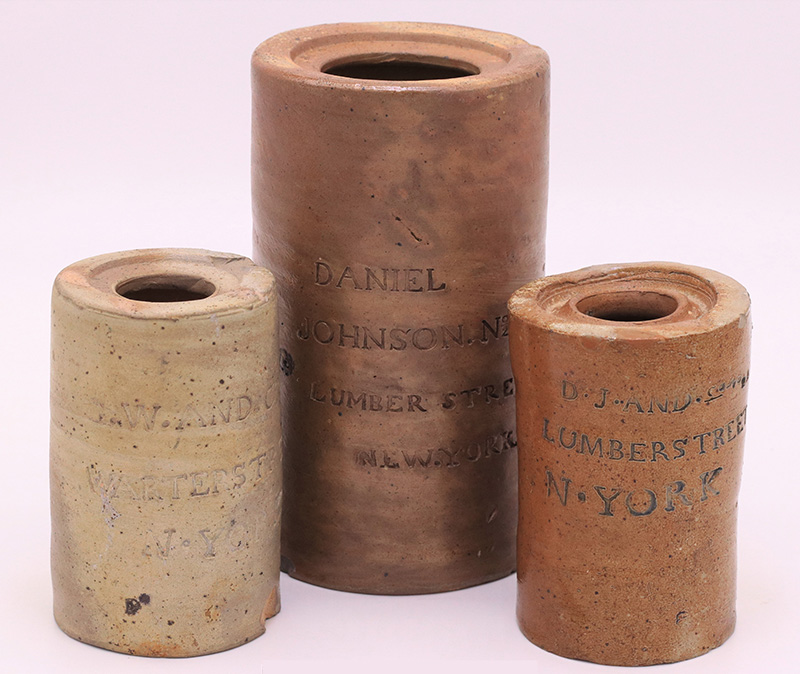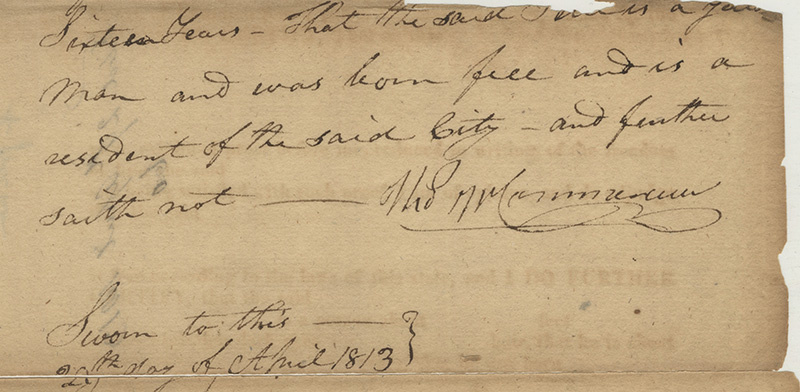Crafting Freedom: The Life and Legacy of Free Black Potter Thomas W. Commeraw
by Margi Hofer and Allison Robinson
The New-York Historical Society has organized the first exhibition devoted to the life and work of Thomas W. Commeraw (c. 1771–1823), a Manhattan stoneware potter whose racial identity and remarkable story were long lost to history. Crafting Freedom, which we curated with potter Mark Shapiro, will be on view from January 27 to May 28, 2023. The exhibition is made possible in part by the support of a Dean F. Failey Grant from the Decorative Arts Trust.
Commeraw’s distinctive stoneware jars and jugs, many of them decorated with exuberant Neoclassical swags and tassels and stamped boldly with his name and location, have been familiar to collectors and curators for well over a century. His pots were collected and interpreted under the erroneous assumption that Commeraw was a white craftsman of European descent. In 2010, Brandt Zipp of Crocker Farm in Sparks, MD, announced a surprising discovery: Federal census records identified Commeraw as Black. Subsequent research by Zipp—who has just published a book about the potter’s life—and by the Crafting Freedom curatorial team document the actual man: a successful free Black entrepreneur and a champion of full rights for African Americans.
Between the late 1790s and 1819, Commeraw produced thousands of utilitarian stoneware jars and jugs, marking them boldly with his name and his striking decoration. Through the display of 22 vessels from his shop, the exhibition will explore Commeraw’s skill at the potter’s wheel, mastery of the kiln, and keen business sense. Another 14 vessels made by his competitors, including Clarkson Crolius Sr., John Remmey, and David Morgan, will illuminate lower Manhattan’s bustling stoneware industry, which served local markets as well as distant ports. The objects are contextualized with historical documents, which outline the growth of Commeraw’s business and his civic engagement, as well as the economic reversals that led to his fateful decision in 1820 to leave the US and journey across the Atlantic for what he hoped would be a brighter future in Sierra Leone.
Crafting Freedom opens by introducing visitors to Commeraw’s tangible legacy: the skillfully thrown and fired salt-glazed stoneware vessels produced at his Corlears Hook workshop, located near the East River just south of today’s Williamsburg Bridge. The jars and jugs churned out by Commeraw and his competitors served as essential household equipment in 18th- and 19th-century American homes, equivalent to the Mason jars and plastic containers we rely on today. Although intended for utilitarian purposes, Commeraw lavished attention on some of his wares. The first vessel that visitors encounter in the exhibition—arguably the finest surviving example of his work—is a richly decorated three-gallon jug that shows him in full command as a master potter (figure 1). Along with its finely rendered ovoid form, refined color, even glazing, and successful firing, the vessel displays a compendium of Commeraw’s decorative motifs and marks. The exhibition presents a roughly chronological exploration of the potter’s wares while also addressing the evolution of his decoration and marking.
The earliest pots that survive from Commeraw’s pottery at Corlears Hook bear floral motifs incised freehand with a stylus (figure 2). The pendulous, cobalt-filled flowers reflect the Germanic tradition of his training yet are distinctly Commeraw’s own. Boldly marked “COERLEARS HOOK” and “N • YORK,” these wares are among the first New York City stoneware vessels marked with a place name. The inclusion of “N • YORK” suggests that his vessels were destined for ports well beyond the city—a marketing strategy that reminded customers to return to that location when they needed to purchase additional pots. Around 1800, several years after starting his own pottery, Commeraw began to use stamped decoration in place of more labor intensive incising. He adopted a signature design—a swag flanked by tassels—straight from the vocabulary of the then-fashionable Neoclassical style (figure 3). The motifs had recently been popularized through pattern books, although Commeraw likely became familiar with them through ornament he saw on furnishings or buildings in New York. With just a few simple tools and some artistic flair, Commeraw and his workers settled on a limited but lively design vocabulary. They used a crescent-shaped stamp for swags, and inverted the same stamp above to create bowknots or clamshells (figure 4). A smaller stamp suggested a tassel or bellflower. Sometime around 1800 he began stamping his wares with his name and location, an early form of product branding. His decision demonstrated business savvy as well as pride in his wares and Commeraw (or his workers) embellished most of his pots with cobalt oxide, fired to a vivid blue, and occasionally employed manganese as well.
Alongside Commeraw’s stoneware, Crafting Freedom traces the arc of the potter’s life against the backdrop of post-Revolutionary New York City and its expanding free Black community. On display are historic documents, some of them just recently uncovered, that helped the curatorial team piece together a life that was all but forgotten. Born enslaved around 1771, Commeraw and his family—parents Tom and Venus and sisters Phyllis and Venus—were freed when potter William Crolius (1731–1779) manumitted them in his will. Young Thomas probably learned the potter’s craft from a member of the Crolius clan at one of the family’s potteries on Potbaker’s Hill. Commeraw married his first wife, Mary Roe, at Trinity Church in 1792 in a ceremony performed by white rector Benjamin Moore. The couple had a son, William, before Mary died of dysentery in 1813. He soon married Ann Jackson, with whom he had two children, Thomas Henry and Ann.
New York City directories trace the growth of Commeraw’s business. He first appeared in the city’s directories in 1795, working at 29 Augustus Street (currently City Hall Place) near the Crolius potteries. By 1797, he had set up his own pottery and kiln at Corlears Hook, then a largely rural neighborhood conveniently located at the water’s edge of the bustling city (figure 5).
Commeraw owned his home and workshop by 1799, a noteworthy accomplishment for any artisan at the time and truly exceptional in an era when African Americans faced significant obstacles. He competed with long-established white potters, including descendants of his former enslaver’s family. A silk ribbon worn by members of the city’s Potters Society (figure 6) serves as a reminder that the city’s skilled workers organized themselves into trade societies that excluded Black artisans. Commeraw’s business expanded despite such challenges. In 1799, he successfully sued John McNeill, a white attorney, for an unpaid promissory note. He also expanded his clientele by forging connections with local Black oystermen, who dominated the city’s thriving oyster trade. He produced straight-sided shipping jars for their pickled oysters, stamped with the producers’ names and addresses (figure 7). Just as he did on his own pottery, Commeraw branded the vessels to promote the businesses of Black entrepreneurs.
Commeraw’s business grew alongside hopes for an end to slavery and the extension of full citizenship rights to those living in freedom, which did not mean full equality for Black New Yorkers after the Revolution. After about 1810, Black people faced greater repression as the city’s population exploded with European immigrants. They experienced increased competition for jobs and housing, along with rising voter suppression, harassment, and violence. Commeraw worked alongside other Black leaders to press for equal treatment of African Americans and the emancipation of his enslaved brethren. In 1809, he took part in a commemoration of the one-year anniversary of the prohibition on American participation in the transatlantic slave trade. A pamphlet in the exhibition from the celebration held at the African Methodist Episcopal Zion Church indicates that Commeraw led the musical program, sang, and wrote a hymn. Another key document on display is the Certificate of Freedom for Peter Johnson, confidently signed by Commeraw in 1813 (figure 8). The only confirmed manuscript in his hand, the document demonstrates how Commeraw marshaled his literacy to advocate for Black voting rights. His sworn statement attested to Johnson’s free status and residency—a recent requirement instituted when New York tightened restrictions for Black voters in 1811. The same year that he vouched for Johnson, Commeraw publicly supported incumbent gubernatorial candidate Daniel Tompkins, “a zealous friend of colored people and in principle and practice opposed to slavery” in a newspaper ad1 intended to rally his fellow freemen to the polls. In 1814, he also mobilized Black men to help build fortifications at Brooklyn Heights to repel an anticipated British invasion during the War of 1812.
The final chapter of Commeraw’s story revolves around his efforts to promote the “return” of free African Americans to Sierra Leone, which he and other supporters of colonization believed would offer greater opportunity than remaining in the United States as unequal citizens. Commeraw traveled there with his extended family in 1820 on the first voyage of the American Colonization Society. He arrived full of optimism with plans to establish a Black republic, but instead he experienced unimaginable hardship and tragedy. What began as a venture for political rights ended as a struggle for survival. Many of the settlers died of malaria, including Commeraw’s wife and niece. He returned to the United States in 1822 and died the following year in Baltimore. The exhibition closes with a coda describing how future generations of the Commeraw family carried forward the potter’s entrepreneurial energy and political engagement.
After its presentation at the New-York Historical Society, Crafting Freedom will travel to the Fenimore Museum in Cooperstown, New York, where it will be on view June 24–September 24, 2023.
- “Meeting of Colored Citizens,” National Advocate [New York], April 27, 1813.
- The conservation of the works shown in figures 3 and 4 was supported through the NYSCA/GHHN Conservation Treatment Grant Program administered by Greater Hudson Heritage Network. This program is made possible by the New York State Council on the Arts with support of the Office of the Governor and the New York State Legislature. Additional support is provided from the Robert David Lion Gardiner Foundation.
Margi Hofer is the Vice President and Museum Director of the New-York Historical Society.
Allison Robinson is the Mellon Foundation Postdoctoral Fellow in Women’s History and Public History at the New-York Historical Society.
A print version of this article was published in The Magazine of the Decorative Arts Trust, one of our most popular member benefits. Join today!

